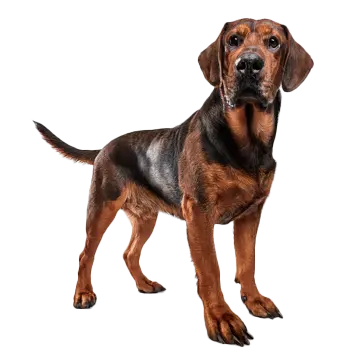The behavioral characteristics of the Rastreador Montanes de Baviera reflect the breed's specialized development as a working tracking dog, combining focused determination when engaged in scent work with a calm, balanced temperament in domestic settings. These dogs demonstrate a remarkable ability to switch between intense working mode and relaxed family companion, making them suitable for households that can provide appropriate outlets for their natural abilities.
When engaged in tracking work, the Rastreador Montanes de Baviera exhibits an almost single-minded focus that can be impressive to observe. The breed demonstrates exceptional concentration, maintaining attention on scent trails for extended periods without becoming distracted by environmental stimuli that might divert other dogs. This intense focus is accompanied by physical behaviors including lowered head position, steady forward movement, and rhythmic breathing patterns that optimize scent detection.
The breed's problem-solving behaviors during tracking work showcase intelligence and adaptability that extend beyond simple following of scent trails. When encountering obstacles, lost trails, or confusing scent patterns, the Rastreador Montanes de Baviera will systematically work to relocate the correct path, often circling back to the last confirmed scent point and working outward in expanding patterns until the trail is recovered. This methodical approach demonstrates both patience and strategic thinking.
Social behaviors of the Rastreador Montanes de Baviera toward humans typically include strong loyalty to family members combined with initial reserve toward strangers. This natural caution serves the breed well in working situations where distractions from unfamiliar people could interfere with tracking tasks. However, with proper introduction and socialization, these dogs usually warm up to new people and can be quite affectionate once trust is established.
The breed's interaction style with family members tends to be gentle and patient, though they may seek regular interaction and attention from their preferred human partners. Many individuals of this breed form particularly strong bonds with one family member, often the person who works with them in tracking activities, though they typically remain friendly and responsive to all household members.
Energy expression in the Rastreador Montanes de Baviera varies significantly depending on the activity context. During tracking work or scent-related activities, these dogs can maintain steady energy output for hours. However, in domestic settings without engaging activities, they tend to be relatively calm and settled, content to rest quietly until presented with stimulating activities.
Play behaviors often reflect the breed's working heritage, with many individuals showing preferences for games that involve searching, scent work, or problem-solving challenges. Traditional fetch games may be less engaging for this breed than activities that challenge their mental capabilities and natural tracking instincts. Hide-and-seek games, scent tracking exercises, and puzzle toys often provide more satisfying entertainment.
The breed's communication style includes vocalizations that vary with context and individual personality. During tracking work, some individuals may bay or bark when following intense scent trails, particularly when approaching the end of a track. In domestic settings, the Rastreador Montanes de Baviera tends to be relatively quiet, using barking primarily for alerting purposes rather than excessive vocalization.
Territorial behaviors in the Rastreador Montanes de Baviera are typically moderate, with the breed serving as effective watchdogs through alerting behaviors rather than aggressive confrontation. They are generally observant of their surroundings and will notify owners of unusual activities or approaching strangers, but they rarely display unprovoked aggression toward people or other animals.
The breed's response to training reflects both intelligence and a degree of independence that stems from their working heritage. While they are highly responsive to consistent, positive training methods, they may question or resist training approaches that seem arbitrary or disconnected from purposeful activity. Training that incorporates elements of scent work or problem-solving tends to be more engaging and effective for this breed.
Stress responses in the Rastreador Montanes de Baviera may include pacing, excessive panting, or attempts to engage in self-directed scent work when their mental and physical needs are not adequately met. The breed requires regular opportunities for challenging mental stimulation, and behavioral problems are more likely to develop when these needs are neglected. Adequate exercise alone is typically insufficient if it doesn't include opportunities for using their natural scenting abilities.
The breed's interaction behaviors with other dogs are generally peaceful, though they may show less interest in typical dog play behaviors than in individual or human-focused activities. Many individuals of this breed coexist well with other dogs in the household, particularly when introduced properly during puppyhood. However, their hunting heritage may make them prone to chasing smaller animals unless specifically trained otherwise.
Adaptability to new situations varies among individuals, but most Rastreador Montanes de Baviera handle environmental changes reasonably well when their basic needs for mental stimulation and physical activity are met. They tend to be most comfortable in settings that provide opportunities for outdoor exploration and scent-related activities, making urban environments challenging unless owners can provide appropriate outlets for natural behaviors.
The breed's learning behaviors demonstrate both quick comprehension of new concepts and good retention of training. They often excel at complex, multi-step tasks and can learn to discriminate between different types of scent work or tracking challenges. However, their learning style tends to be methodical rather than impulsive, and they may need time to process and internalize new training concepts before demonstrating mastery.
Age-related behavioral changes in the Rastreador Montanes de Baviera typically include gradual reduction in physical activity levels while maintaining mental acuity and interest in scent work well into their senior years. Many older individuals can continue to participate in modified tracking activities, and their experience often makes them valuable training partners for younger dogs learning tracking skills.

